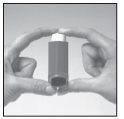
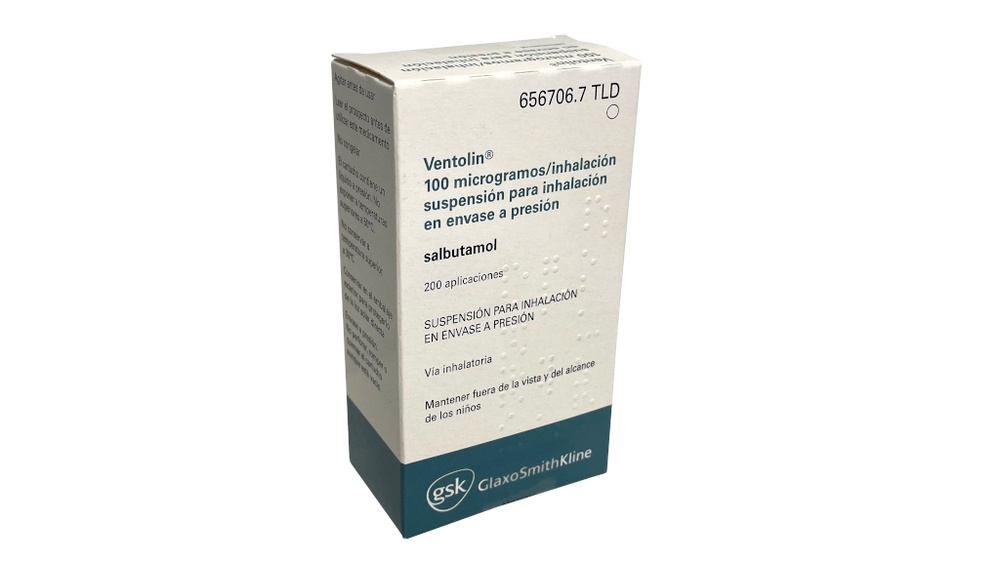
VENTOLIN 100 micrograms/INHALATION PRESSURED INHALER SUSPENSION

Ask a doctor about a prescription for VENTOLIN 100 micrograms/INHALATION PRESSURED INHALER SUSPENSION

How to use VENTOLIN 100 micrograms/INHALATION PRESSURED INHALER SUSPENSION
Introduction
Package Leaflet: Information for the Patient
Ventolin 100 micrograms/inhalation suspension for inhalation in a pressurized container
salbutamol
Read this package leaflet carefully before you start using this medicine, because it contains important information for you.
- Keep this package leaflet, you may need to read it again.
- If you have any further questions, ask your doctor or pharmacist.
- This medicine has been prescribed for you only. Do not pass it on to others. It may harm them, even if their symptoms are the same as yours.
- If you experience any side effects, talk to your doctor or pharmacist. This includes any possible side effects not listed in this package leaflet. See section 4.
Contents of the package leaflet
- What is Ventolin and what is it used for
- What you need to know before you start using Ventolin
- How to use Ventolin
- Possible side effects
- Storing Ventolin
- Contents of the pack and further information
1. What is Ventolin and what is it used for
Ventolin 100 micrograms/inhalation suspension for inhalation in a pressurized container is indicated for adults, adolescents, and children aged 4 to 11 years (for children under 4 years, see section 3), in the following cases:
- Rescue medication in mild, moderate, or severe asthma.
- Prevention of bronchospasm (difficulty breathing or wheezing) induced by physical exercise or before exposure to a known and unavoidable allergenic stimulus.
2. What you need to know before you start using Ventolin
Do not use Ventolin
- if you are allergic to salbutamol or any of the other ingredients of this medicine (listed in section 6).
- to stop premature labor or threatened abortion.
Warnings and precautions
Talk to your doctor or pharmacist before you start using Ventolin if:
- you have had to stop using this or any other medicine for the treatment of this disease due to allergy or any other problem
- you have high blood pressure
- you have hyperthyroidism (increased activity of the thyroid gland)
- you have a history of heart problems, such as rapid or irregular heartbeat or angina (chest pain)
- you have low potassium levels in your blood
- you are taking xanthine derivatives (such as theophylline) or steroids to treat asthma
- you are taking diuretics, which are sometimes used to treat high blood pressure or heart problems.
Your doctor will monitor your potassium levels if you are taking xanthine derivatives, steroids, or diuretics.
Talk to your doctorif you think you may have any of these problems.
If the use of this medicine does not provide relief for at least three hours, talk to your doctor. Sometimes this medicine may not be suitable, and your doctor may want to change it to a different one.
Other medicines and Ventolin
Tell your doctor or pharmacist if you are taking, have recently taken, or might take any other medicines, including those obtained without a prescription.
Some medicines may affect the way Ventolin works or make it more likely that you will have side effects. These include:
- Non-selective beta-blockers, such as propranolol, used to treat high blood pressure or heart problems.
- Monoamine oxidase inhibitors (MAOIs), used to treat depression.
Your doctor or pharmacist will decide if you should use Ventolin with these medicines.
Pregnancy and breastfeeding
If you are pregnant or breastfeeding, think you may be pregnant, or plan to become pregnant, talk to your doctor or pharmacist before using this medicine.
If it is necessary to administer Ventolin during pregnancy or breastfeeding, your doctor will carefully weigh the benefits and potential risks based on the severity of the clinical condition.
Driving and using machines
No studies have been conducted on the ability to drive and use machines.
Important information about some of the ingredients of Ventolin
Some patients may notice a different sensation or taste compared to the previous Ventolin inhaler formulation they used, because the propellant has been replaced with a new one that does not contribute to the depletion of the ozone layer.
Use in athletes
This medicine contains salbutamol, which may produce a positive result in doping tests.
3. How to use Ventolin
Follow the administration instructions for this medicine exactly as indicated by your doctor. If in doubt, consult your doctor or pharmacist again.
Remember to use your medicine.
Your doctor will indicate the duration of your treatment with Ventolin. Do not stop treatment before.
This medicine produces a fine mist that is inhaled into the lungs. Make sure you know how to use the inhaler correctly. If you have any problems, ask your doctor or pharmacist.
The recommended starting dose for relieving symptoms or acute asthma attacksis:
Adults:one application (100 micrograms) or two applications (200 micrograms), once a day.
Children over 12 years:one application (100 micrograms) or two applications (200 micrograms), once a day.
Children under 12 years:one application (100 micrograms) once a day. Your doctor may increase it to two applications (200 micrograms) once a day.
The use of Ventolin on demand should not exceed four times a day. The need for additional use or a sudden increase in dose indicates a worsening of the asthma disease.
The recommended starting dose for preventing symptoms or asthma attacks induced by allergens or exerciseis:
Adults:two applications (200 micrograms) 10 to 15 minutes before exercise or exposure to the allergen.
Children over 12 years:two applications (200 micrograms) 10 to 15 minutes before exercise or exposure to the allergen.
Children under 12 years:one application (100 micrograms) 10 to 15 minutes before exercise or exposure to the allergen. Your doctor may increase it to two applications (200 micrograms) before exercise or exposure to the allergen.
The recommended starting dose for continued use(together with the usual anti-inflammatory medication for asthma, inhaled corticosteroid) is:
Adults, children over 12 years, and under 12 years:one application (100 micrograms) or two applications (200 micrograms), once a day.
The maximum dose is 800 micrograms (two inhalations up to four times in a 24-hour period).
Do not inhale more applications or use your inhaler more frequently than indicated by your doctor.
Your doctor may indicate that you inhale more applications as emergency treatment if your wheezing or breathing worsens. It is essential that you follow your doctor's instructions regarding the number of applications and frequency.
Some people may find it difficult to release an application just before inhaling. Inhalation chambers can help solve this problem. Your doctor or pharmacist will advise you.
Babies and young children may benefit from using Ventolin through the use of a pediatric inhalation chamber with a mask (such as Babyhaler). Your doctor or pharmacist will advise you.
If, immediately after administering the medicine, your breathing or difficulty breathing starts to worsen, stop using it immediately and inform your doctor as soon as possible.
Ventolin should be used on demand and not regularly.
If your asthma is active (for example, you have symptoms or frequent attacks, such as difficulty breathing that makes it hard to speak, eat, or sleep, coughing, wheezing, chest tightness, or limited physical ability), you should inform your doctor immediately, who may start administering a medication or increase the dose of treatment, such as an inhaled corticosteroid, to control your asthma.
Tell your doctor as soon as possible if your medicine seems not to be working as well as usual (for example, if you need higher doses to relieve your respiratory problems or if your inhaler does not provide relief for at least 3 hours), as your asthma may be worsening, and you may need a different medication.
If you use Ventolin more than two times a week to treat your asthma symptoms, without including preventive use before exercise, this indicates poorly controlled asthma and may increase the risk of severe asthma attacks (worsening of asthma) that can have serious complications and can be life-threatening. You should contact your doctor as soon as possible to review your asthma treatment.
If you use a daily anti-inflammatory medication for your lungs, e.g., an "inhaled corticosteroid," it is essential that you continue to use it regularly, even if you feel better.
If you think the effect of Ventolin is too strong or too weak, tell your doctor or pharmacist.
Read these instructions carefully before using your medication.
Instructions for use:
Ventolin produces a fine mist that is inhaled through the mouth into the lungs. Your doctor or pharmacist should indicate how to use the inhaler device. If in doubt, consult your doctor or pharmacist.
Checking the inhaler:
Before using the inhaler for the first time, remove the mouthpiece cover by squeezing it gently on the sides, shake the inhaler thoroughly, and release two doses into the air to ensure the inhaler is working. If the inhaler has not been used for 5 or more days, shake it thoroughly and release two doses into the air to ensure it is working.
Using the inhaler:
- Remove the mouthpiece cover by squeezing it gently on the sides.
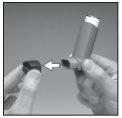
- Check that there are no foreign particles inside and outside the inhaler, including the mouthpiece.
- Shake the inhaler well to ensure that any foreign particles are removed and the inhaler contents are mixed properly.
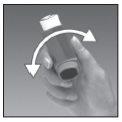
- Hold the inhaler vertically between your index and thumb fingers, placing your thumb on the base, below the mouthpiece. Breathe out as much as you reasonably can.
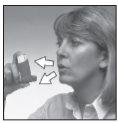
- Insert the mouthpiece into your mouth, between your teeth, closing your lips around the device, but not biting it.
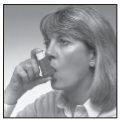
- Immediately after starting to breathe in through your mouth, press the inhaler to release the salbutamol, and continue breathing in deeply and steadily.
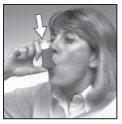
- Hold your breath, remove the inhaler from your mouth, and remove your index finger from the top of the inhaler. Continue holding your breath for as long as you reasonably can.
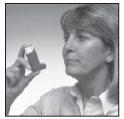
- If you are going to administer another inhalation, keep the inhaler vertical and wait for about half a minute before repeating steps 3 to 7.
- Replace the mouthpiece cover by pushing it firmly and closing it with a snap so that the cap is in place.
Important
Do not perform steps 5, 6, and 7 quickly. It is essential to start breathing in slowly just before pressing the inhaler. Practice in front of a mirror the first few times. If you see a "mist" coming out of the top of the inhaler or the sides of your mouth, start again from step 2.
Patients who have difficulty coordinating the handling of the inhaler with inhalation may use an appropriate inhalation chamber, Volumatic(adults and children over 5 years) or Babyhaler(children from 1 to 5 years).
If your doctor gave you different instructions, follow them carefully. Consult your doctor or pharmacist if you have difficulties.
Children:
Young children may need help, with an adult handling the inhaler for them. Encourage the child to breathe out and activate the inhaler just after the child starts breathing in. Practice the technique together.
Older children or people with fragile hands should hold the inhaler with both hands; they should put their two index fingers on the top of the inhaler and their two thumbs on the base, below the mouthpiece.
Cleaning the inhaler
Clean the inhaler at least once a week.
- Remove the metal cartridge from the plastic inhaler casing and remove the mouthpiece cover.
- Rinse the plastic casing with warm water.
- Let the plastic casing dry inside and outside in a temperate place, avoiding excessive heat.
- Replace the metal cartridge and mouthpiece cover.
You can add a mild detergent or a solution of the type used to clean baby bottles to the water. Rinse thoroughly with clean water before drying.
Do not put the metal cartridge in water.
If you use more Ventolin than you should
In case of overdose or accidental ingestion, consult your doctor or pharmacist immediately or call the Toxicology Information Service, phone 91 562 04 20, indicating the medicine and the amount ingested.
If you accidentally take a higher dose than recommended, you are more likely to experience side effects such as rapid heartbeat, headaches, tremors, or muscle cramps (see Possible side effects). You should inform your doctor as soon as possible if the dose you have taken is higher than recommended.
If you forget to use Ventolin
Do not take a double dose to make up for forgotten doses. Simply inhale the next dose when it is due, or before if you start to feel breathless. Your doctor will have told you to use your inhaler regularly every day or only when your breathing worsens.
4. Possible Adverse Effects
Like all medicines, this medicine can cause adverse effects, although not all people suffer from them.
Some people may be allergic to medicines. If you experience any of the following symptoms immediately after using Ventolin, discontinue treatment and inform your doctor as soon as possible.
Symptoms to be aware of:
Allergic reactions:are very rare in patients using Ventolin. They include signs:
- sudden onset of "wheezing" or chest tightness
- swelling of eyelids, face, or lips
- skin rash (hives) or urticaria anywhere on the body
- sudden feeling of weakness or dizziness (can lead to collapse or loss of consciousness).
Contact your doctor immediatelyif you suffer from any of these symptoms. Stop using Ventolin.
The following are adverse effects associated with salbutamol, classified by organ, system, and frequency. The meaning of the terms used to describe the frequency of adverse effects is as follows:
Very common: may affect more than 1 in 10 patients.
Common: may affect up to 1 in 10 patients.
Uncommon: may affect up to 1 in 100 patients.
Rare: may affect up to 1 in 1,000 patients.
Very rare: may affect up to 1 in 10,000 patients.
Inform your doctor if you have any of the following symptoms:
Immune system disorders
Very rare: hypersensitivity reactions (allergic) including angioedema (skin reactions with erythema, edema, and itching), urticaria, bronchospasm (narrowing of the bronchial walls with decreased air intake), hypotension, and collapse.
Metabolic and nutritional disorders
Rare: hypokalemia (low potassium levels in the blood).
Therapy with β2 agonists may lead to potentially severe hypokalemia.
Nervous system disorders
Common: tremor, headache.
Very rare: hyperactivity (agitation and excitability).
Cardiac disorders
Common: tachycardia (increased heart rate).
Uncommon: palpitations (irregular heartbeat).
Very rare: cardiac arrhythmias, including atrial fibrillation, supraventricular tachycardia, and extrasystoles (heart rhythm disorders).
Although it is not known exactly how often it occurs, some people may occasionally experience chest pain (due to heart problems such as angina). Inform your doctor if you develop these symptoms while being treated with salbutamol, but do not stop taking it unless told to do so.
Vascular disorders
Rare: peripheral vasodilation (dilation of peripheral blood vessels).
Respiratory, thoracic, and mediastinal disorders
Very rare: paradoxical bronchospasm (narrowing of the bronchial walls with decreased air intake).
Gastrointestinal disorders
Uncommon: irritation of the mouth and throat.
Musculoskeletal and connective tissue disorders
Uncommon: muscle cramps.
Reporting of adverse effects:
If you experience any type of adverse effect, consult your doctor or pharmacist, even if it is a possible adverse effect that does not appear in this leaflet. You can also report them directly through the Spanish Pharmacovigilance System for Human Use Medicines: www.notificaRAM.es. By reporting adverse effects, you can contribute to providing more information on the safety of this medicine.
5. Storage of Ventolin
Keep this medicine out of the sight and reach of children.
Do not store at a temperature above 30°C. Do not freeze. Store in the outer packaging to protect it from direct sunlight.
Place the mouthpiece protector firmly and click it into place.
If the inhaler is very cold, remove the cartridge and warm it with your hand for a few minutes before use. Do not use any other method to heat it.
The cartridge contains a pressurized liquid. Do not expose to temperatures above 50°C. Do not pierce, break, or burn the cartridge even if it is empty.
Do not use this medicine after the expiration date stated on the packaging after CAD. The expiration date is the last day of the month indicated.
Medicines should not be disposed of via wastewater or household waste. Deposit the packaging and medicines you no longer need at the SIGRE point in the pharmacy. In case of doubt, ask your pharmacist how to dispose of the packaging and medicines you no longer need. This way, you will help protect the environment.
6. Package Contents and Additional Information
Composition of Ventolin 100 micrograms/inhalation suspension for inhalation in a pressurized container
- The active ingredient is 100 micrograms of salbutamol (as salbutamol sulfate) per application.
- The other components are norflurane (HFA134a).
This medicine contains fluorinated greenhouse gases.
Each inhaler contains 18 g of HFC-134a (also known as norflurane or HFA 134a), which corresponds to 0.0257 tons of CO2 equivalent (global warming potential GWP = 1,430).
Appearance of the product and package contents
Each package contains an inhaler that provides 200 applications.
Marketing authorization holder and manufacturer
Marketing authorization holder:
GlaxoSmithKline, S.A.
P.T.M. C/ Severo Ochoa, 2
28760 Tres Cantos (Madrid)
Tel: +34 900 202 700
Manufacturer:
Glaxo Wellcome, S.A.
Avda. de Extremadura, 3
09400 – Aranda de Duero (Burgos)
O
Glaxo Wellcome Production
Zone Industrielle nº 2, 23 Rue Lavoisier, La Madeleine, 27000 Evreux, France.
Tel: + 33 2 3223 5500
Fax: +33 2 3223 5558
Date of the last revision of this leaflet: 01/2025
Detailed and updated information on this medicine is available on the website of the Spanish Agency for Medicines and Health Products (AEMPS) http://www.aemps.gob.es/

How much does VENTOLIN 100 micrograms/INHALATION PRESSURED INHALER SUSPENSION cost in Spain ( 2025)?
The average price of VENTOLIN 100 micrograms/INHALATION PRESSURED INHALER SUSPENSION in December, 2025 is around 4.09 EUR. Prices may vary depending on the region, pharmacy, and whether a prescription is required. Always check with a local pharmacy or online source for the most accurate information.
- Country of registration
- Average pharmacy price4.09 EUR
- Active substance
- Prescription requiredYes
- Manufacturer
- This information is for reference only and does not constitute medical advice. Always consult a licensed doctor before taking any medication. Oladoctor is not responsible for medical decisions based on this content.
- Alternatives to VENTOLIN 100 micrograms/INHALATION PRESSURED INHALER SUSPENSIONDosage form: PULMONARY INHALATION, 0.12% w/v SALBUTAMOL SULFATEActive substance: salbutamolManufacturer: Laboratorio Aldo Union S.L.Prescription requiredDosage form: PULMONARY INHALATION, 0.24% w/v SALBUTAMOL SULFATEActive substance: salbutamolManufacturer: Laboratorio Aldo Union S.L.Prescription requiredDosage form: PULMONARY INHALATION, 100 micrograms/applicationActive substance: salbutamolManufacturer: Laboratorio Aldo Union S.L.Prescription required
Alternatives to VENTOLIN 100 micrograms/INHALATION PRESSURED INHALER SUSPENSION in other countries
The best alternatives with the same active ingredient and therapeutic effect.
Alternative to VENTOLIN 100 micrograms/INHALATION PRESSURED INHALER SUSPENSION in Poland
Alternative to VENTOLIN 100 micrograms/INHALATION PRESSURED INHALER SUSPENSION in Ukraine
Online doctors for VENTOLIN 100 micrograms/INHALATION PRESSURED INHALER SUSPENSION
Discuss dosage, side effects, interactions, contraindications, and prescription renewal for VENTOLIN 100 micrograms/INHALATION PRESSURED INHALER SUSPENSION – subject to medical assessment and local rules.




